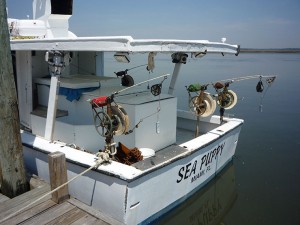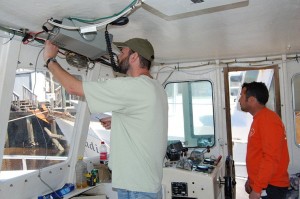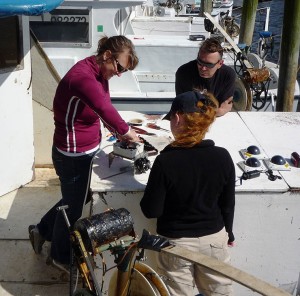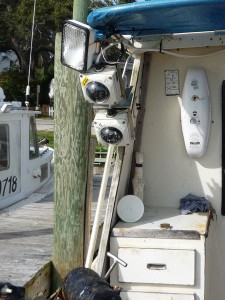By E-CHING LEE
“The ocean is just like the serengeti,” says Reece Hair, a snapper grouper fisherman based in South Carolina. “Just got water over the top of it.”
But that water can obscure a lot of data. Just ask the South Atlantic Fishery Management Council. It is working to collect sufficient information on the snapper grouper fishery in the region to set and update fishing regulations.
“We just don’t have the resources to have that accurate picture of what’s actually happening on the water,” acknowledges Brian Cheuvront, the council’s fisheries economist.
“Having more accurate estimates of catch and bycatch could actually help fishermen in the long run,” he continues.

Bandit reels are names for their resemblance to casinos’ one-armed slot machines. Photo by Scott Baker.
Currently, the SAFMC requires fishermen in the snapper grouper fishery to self-report information in logbooks. Human observers are occasionally placed on a handful of boats to record data, but there are no dedicated funds for an observer program for the fishery.
Some snapper grouper permit holders, including Phil Conklin from South Carolina and Charlie Phillips from Georgia, asked Sea Grant fisheries specialists Scott Baker from North Carolina and Amber Von Harten from South Carolina to conduct a study to determine if electronic video monitoring could be a cost-effective and efficient alternative to those two methods.
“In theory, it doesn’t seem to be as intrusive as having an observer on your boat, and management could essentially turn it on and off when needed,” Baker notes. “It collects a wealth of information that hopefully could be used to benefit the industry.”
Kenny Fex from North Carolina and Mark Mahefka from South Carolina joined Hair, Conklin and Phillips on the project. For logistical purposes, this study involved vessels in the northern half of the SAFMC jurisdiction and did not include Florida.
Their work was supported by a National Oceanic and Atmospheric Administration Cooperative Research Program Grant. This program encourages collaboration in research between scientists and fishermen, requiring that anglers be part of the data-collection process.
JUST ANOTHER TOOL
Snapper grouper permit holders are required to keep logbooks for each trip. The information is used to document fishing effort and the catch that is landed, which can be verified when the vessel unloads.
However, there currently is no way to validate the number of discarded fish reported in logbooks because this happens at sea. Furthermore, the data can be inaccurate if the records are completed at the end of a trip, long after fishing is complete. According to Baker, for these reasons, scientists are sometimes hesitant to use the data other than to determine fishing effort and landed catch.
Funding from the same cooperative research program allows scientists to put observers on a handful of boats, providing a wealth of information.
“Human observers are considered the gold standard in terms of what’s happening out there because it’s an independent voice,” Baker says. But at a cost of more than $1,300 per day at sea per observer, it quickly adds up to a “crazy amount of money.” At that price, the observer program is not scalable to the entire fleet.
Still, funding for observers is very limited and is not guaranteed from year to year. Also, adding another person to these small fishing boats is often a challenge.
Enter electronic video monitoring, or EM.
“EM has the potential to improve the existing knowledge of the snapper grouper complex since it records not only fish that are landed, but also species that are released due to regulations or because they do not have marketable value,” explains Jack McGovern, project monitor and NOAA fisheries biologist.

Scott Baker installs EM wiring in a vessel wheelhouse. Photo by Amber Von Harten.
Baker and Von Harten theorized that EM would cost less than observers, be more reliable than self-reported logbooks, and not place an additional burden on the fishermen. The Canadian Department of Fisheries and Oceans currently uses this method to validate self-reported data from fishermen. Also, EM can be deployed in instances where safety or space limitations prevent a human observer from being present.
McGovern notes that EM could fill in critical missing information about discards within the fishery. “There is a need to characterize the entire catch of commercial fishermen, not just what is landed. The magnitude and composition of bycatch is not well known. Information from EM has the potential to enhance that knowledge,” he says.
The Sea Grant specialists wanted to assess EM’s price tag. “We couldn’t really understand that until we figured out how these boats fished, how the cameras worked on the boats, how much of the data can be analyzed accurately, and how to hone down the handling practices of the fish on board to capture that data that you need,” Von Harten notes.
Another goal was to determine if EM could bridge the informational quality and quantity gap between observers’ data and fishermen’s logbooks.
“From a larger perspective, this study is: Can we collect the same level of information that they’re collecting but at a reduced cost and reduced hassle to human observers?” Baker explains. Available research states that this is possible, depending on the fishery, he adds.
SETTING UP
For the study, Baker and Von harten worked with boats that use vertical hook-and-line reels, known as bandit gear. These electric or hydraulic reels are so nicknamed because of their resemblance to casinos’ one-armed bandit slot machines.
“They are fast, mobile vessels that can quickly traverse to the fishing grounds and have large enough fish holds to stay out for an extended period of time,” Von Harten explains. These boats are configured so that the reels are positioned to fish off the port, starboard and stern of the vessel, allowing fishermen to use three or more reels at once.
The team contracted with Archipelago Marine Research Ltd. for equipment and services to carry out a pilot study on six boats.
“It’s a complex fishery to monitor,” recalls Howard McElderry, Archipelago’s head of fishery monitoring technologies. “We had done some work with the vertical longline fishery before but not a lot, and certainly not as complicated as the South Atlantic.”

The system shows live images from four cameras. Photo by Scott Baker.
However, these very issues made the work interesting. “Just the vast number of species and the speed at which the fish are coming up from a variety of points on the boat — that presented quite a unique challenge for us in terms of being able to capture all this fishing activity accurately and completely,” points out Adam Batty, the Archipelago project manager.
Each boat had four cameras, a sensor to turn on the cameras when a reel moved, a GPS device and a control box. The fixed cameras were pre-focused such that all fishing activity on the back deck could be recorded.
The system recorded video streams on hard drives, and once those were full, Baker and Von Harten replaced them. Then Baker sent the drives to Archipelago to analyze for species caught and fishing effort, among other details.
In addition, the fisheries specialists provided local tech support, going to service the equipment after trips or when there were problems. They did a lot of tweaking to adjust the EM devices for the individual boats and for how the anglers fished — fast, in tight spaces, on long trips that could last up to two weeks, and often in rough seas.
By the close of the study, the pair had picked up some new skills. “We really felt like we were handymen by the end of the project after troubleshooting problems with the equipment and using our toolboxes to fix and tweak adjustments on camera lenses and hardware,” Von Harten jokes.
ANALYZING THE DATA
The fishermen took 93 trips during the eight-month study with EM systems onboard. An independent observer went out on five of those trips, and his records were compared with the data that were collected by the EM systems. Baker and Von Harten also created a special project logbook for fishermen to record catch and effort details to compare with the EM data.
The researchers found that EM and observer data matched well for overall fish count, but fish counts recorded by fishermen varied in levels of agreement to EM. Some fishermen were better at data collection than others.
“The project also demonstrated that there was the potential to obtain information on species identification and length of discarded fish,” McGovern says.
“The hard part was breaking down the identity of those species that may come across the camera, including the ones that are discarded,” Baker says. “As you can imagine, a lot of them look very similar.” For example, some common species such as vermilion snapper were easily identified, while others such as black sea bass were harder to distinguish.

Amber Von Harten, Kim Astle and Kenneth Fex prepare for installation. Photo by Scott Baker.
Furthermore, reviewers had to contend with the different fishing styles and the speed at which the anglers fished. Often, very little time elapsed between the end of one fishing event and the beginning of another. That made it difficult to come to a consensus on how to define a single fishing event, which would be necessary if EM is to be further explored for this fishery.
“Time is money to them,” Von Harten explains. “The faster they can discard the fish that they’re not going to keep or get the fish on board that they are going to keep, it makes all the difference.”
Data analysis — mainly the time spent identifying and counting fish — turned out to be the most expensive part of the project.
“A lot of the costs are actually going to be in coming up with a plan to figure out how you’re going to analyze and use that information,” Baker says. “You’ve got to figure out which information is important for you to use.”
Without that plan in place, the EM system “could just be an expensive piece of equipment on your boat,” he adds.
“Nonetheless, the data will be there,” counters the council’s Cheuvront, “which is something we’ve never had before.”
LOOKING AHEAD
Fex, the sole North Carolina fisherman in the project, has praise for the pilot study. “The good thing about it is that it’s true science,” he explains. “And it made me realize the amount of discards and things like that.” However, he has reservations about deploying the system across the entire snapper grouper fleet, mostly because of cost.
In fact, Baker and Von Harten recommend that with tweaking, EM has the potential to augment, rather than replace, existing data collection programs. One possible use of EM is as an audit system to verify a portion of the fishermen’s logbook data.
And even though EM was effective in collecting data, “there’s certainly a big learning curve that needs to be incorporated for this to be effective,” Baker acknowledges.

EM cameras are mounted on the vessel so that the reels are in view. Photo by Scott Baker.
“Putting technology on a boat isn’t something you just do and forget about. You have to actively work with it,” Archipelago’s Batty concurs. “Very often it affects the way catch is handled, places where discarding occurs, all those sort of things. So it becomes a bigger method.”
However, others are learning from these lessons. When the Ocean Conservancy started a similar pilot study in the Gulf of Mexico for reef fish, Baker was invited to share advice and lessons learned.
“Scott’s knowledge of the challenges in maintaining equipment and traveling to multiple sites helped us prepare for the amount of work that would realistically be needed to successfully complete the tasks. Scott also shared guidance on the qualifications we should look for in an observer,” says Kristy Tavano, the coordinator for the Gulf project.
“The work that we did with Sea Grant really helped us to know what we were up against and plan a little bit better for the installations,” adds Batty, who also is managing the Gulf project for Archipelago. In addition, he used some of the video feed from Baker’s study to familiarize his technicians with the type of fishery they would encounter.
Although Von Harten doesn’t see the EM system being deployed on all boats in the fleet, she suggests there could be a potential follow-on project in the snapper grouper fishery.
“If there was a small segment of the fleet that wanted to do more pilot testing of the equipment to really hone down on how this could effectively work on their boats, I think that would probably be the next step,” she suggests.
But even though he agrees that the EM technology is very useful, Cheuvront has several caveats.
“For this to work, we need to get the buy-in from the fishermen and we need to get the resources from management to actually deploy the technology,” he cautions, citing the need to have funding to support the EM work.
“The link between deploying the gear and its use in management has to happen very rapidly or it’s going to lose whatever support it has from the fishermen,” Cheuvront advises.
To learn more about the snapper grouper complex and its related management plan, go to: www.safmc.net and click on Fishery Management Plans in the Quick Links box. Then search for snapper grouper.
Electronic Video Monitoring Survey
Scott Baker and Amber Von Harten recently surveyed 773 snapper grouper permit holders on electronic video monitoring research. Fifteen percent, or 116 people, responded.
Responses were grouped according to coastal region. Fifty-four percent of permit holders responding from North and South Carolina, and Georgia were supportive of additional testing of EM systems. However, 75 percent of the Florida respondents were opposed.
When asked if a third-party data review method such as EM might be considered as a tool to validate self-reported logbook records, more than 60 percent in each group were opposed to the concept.
Likewise, when asked if they would support the adoption of standardized fish-handling guidelines to improve the video-review process if EM was to be further evaluated, more than 75 percent of respondents were not in favor.
This article was published in the Autumn 2012 issue of Coastwatch.
For contact information and reprint requests, visit ncseagrant.ncsu.edu/coastwatch/contact/.
